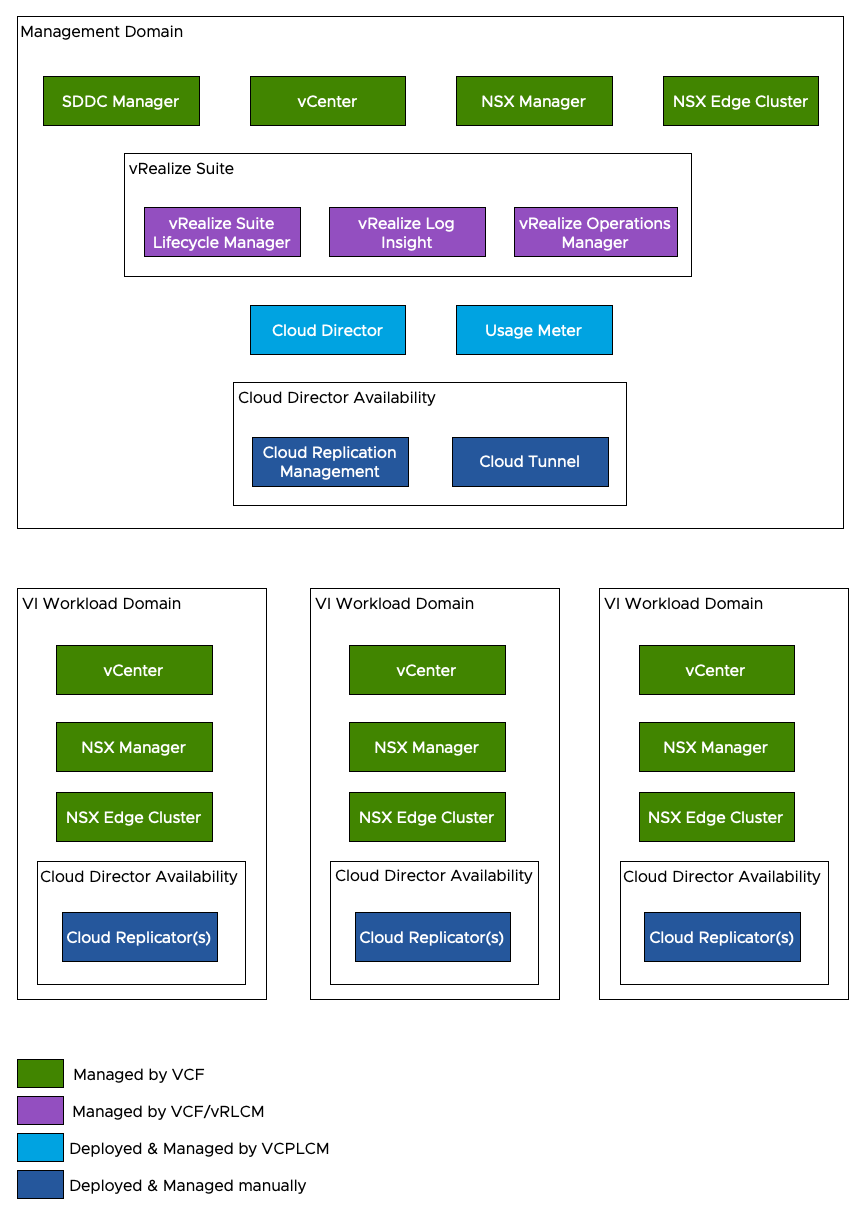DR and Migration Logical Design #
The DR and Migration solution is comprised of the following VMware Cloud Director Availability components:
Cloud Replication Management Appliance #
The Cloud Replication Management appliance is responsible for the communication with VMware Cloud Director. Based on this communication, it discovers resources (OrgVCD, storage policies, datastores, networks, etc.) managed by VMware Cloud Director and used by the tenants. This information is required for discovering vApps/VMs that can be replicated/migrated or suitable destination locations for incoming replications/migrations.
It also provides the VMware Cloud Director Availability UI and API interfaces. Another role of this appliance is to communicate with all the local and remote Replicators and receive data regarding each protected/migrated workload. Two VMware Cloud Director Availability services cover these functionalities in Cloud Replication Management appliance – the cloud.service and the manager.service.
Cloud Service #
This service understands the VMware Cloud Director constructs – OrgVCD, vApps, networks managed by VMware Cloud Director, storage policies, etc. To achieve this VMware Cloud Director Availability Cloud Management appliance communicates with the VMware Cloud Director API through the VMware Cloud Director LB. The Cloud Replication Management appliance does not communicate with the VMware Cloud Director consoleproxy cells/interfaces. Based on this, VMware Cloud Director Availability can:
- discover VMware Cloud Director managed vApps/VMs and protect/migrate them to another DR-enabled cloud or on-premises vCenter
- discover a suitable destination for incoming replications/migrations
The cloud service manages pairings with other DR-enabled clouds, policies, SLA profiles, and their assignment to VMware Cloud Director organizations. It provides information about the replication and system tasks. Also, it reports the replication compute resources consumption per tenant and per PVDC, the storage consumption per datastore, plus many other high- and low-level details.
The cloud service management interface is available on https://vcda_manager_fqdn:443/admin. It is possible to log in with the local OS root account, an SSO account if the appliance has registration in an SSO domain, or with a VMware Cloud Director System Administrator account if the initial configuration is already completed.
Manager Service #
The manager service manages the registrations of local and remote replicators. During the pairing process, remote replicators are registered in the Cloud Replication Management appliance. For each replication, it chooses one replicator from the source site and one from the destination site. The destination replicator is responsible for discovering the appropriate resources to create the replica disks at the destination and write data. Replicators send information to the Cloud Replication Management appliance about their operation – statuses, amount of data replicated, operation start time, time to complete, etc.
The manager service is also used to manage replicators. It can trigger the rebalancing of replications across all replicators or put a replicator in maintenance mode, which leads to assigning each of its replications to another one. This is useful when the current replicators need to be offloaded by adding a new replicator in the solution.
The manager service management interface is available at https://vcda_manager_fqdn:8441. It is possible to log in with the local OS root account and an SSO account if the appliance is already registered in Lookup Service.
Cloud Replicator #
Cloud Replicator is responsible for moving the replication data around - to and from the ESXi hosts and the cloud. For outgoing replications/migrations, it communicates with the VMKernel interface of the ESXi host, captures and encrypts replication data, optionally compresses it, and sends it to the remote replicator, which can be another Cloud Replicator or on-premises Replicator. For incoming replications/migrations the Cloud Replicator receives replication data from a Replicator (cloud or on-premises), decompresses and decrypts this data, and sends it to the ESXi to be written on a datastore. Cloud Replicator is the only component that can scale out as the number of protections/migrations increases.
Cloud Tunnel #
The Cloud Tunnel appliance is the single-entry point to the VMware Cloud Director Availability instance in the cloud. Its role is to handle and forward the incoming management and replication traffic. It is the only VMware Cloud Director Availability appliance that needs a dedicated Internet-accessible endpoint. A second Cloud Tunnel appliance can be deployed to maintain high availability and load balancing.
Logical Design For Product Deployment #
The logical design provides a high-level overview of the solution design.
Based on the standard architecture, most of the components will be deployed in the management domain except for Cloud Replicator(s) that will be deployed in the VI Workload Domain(s).
